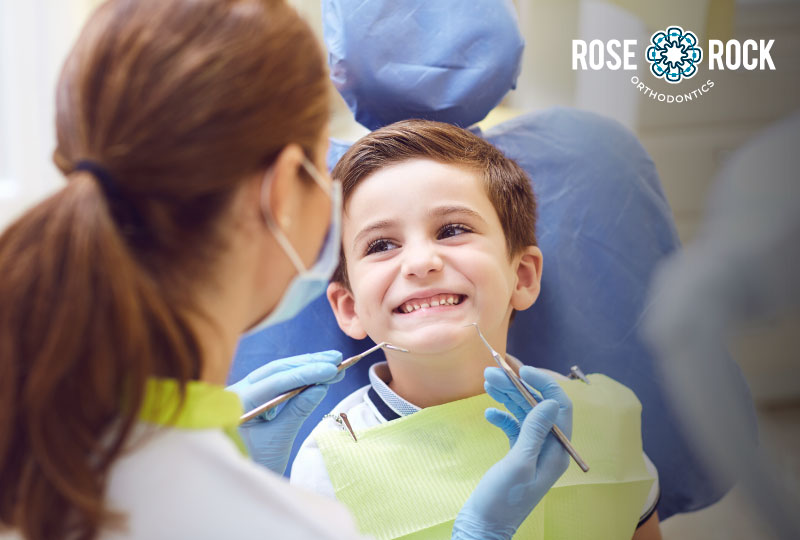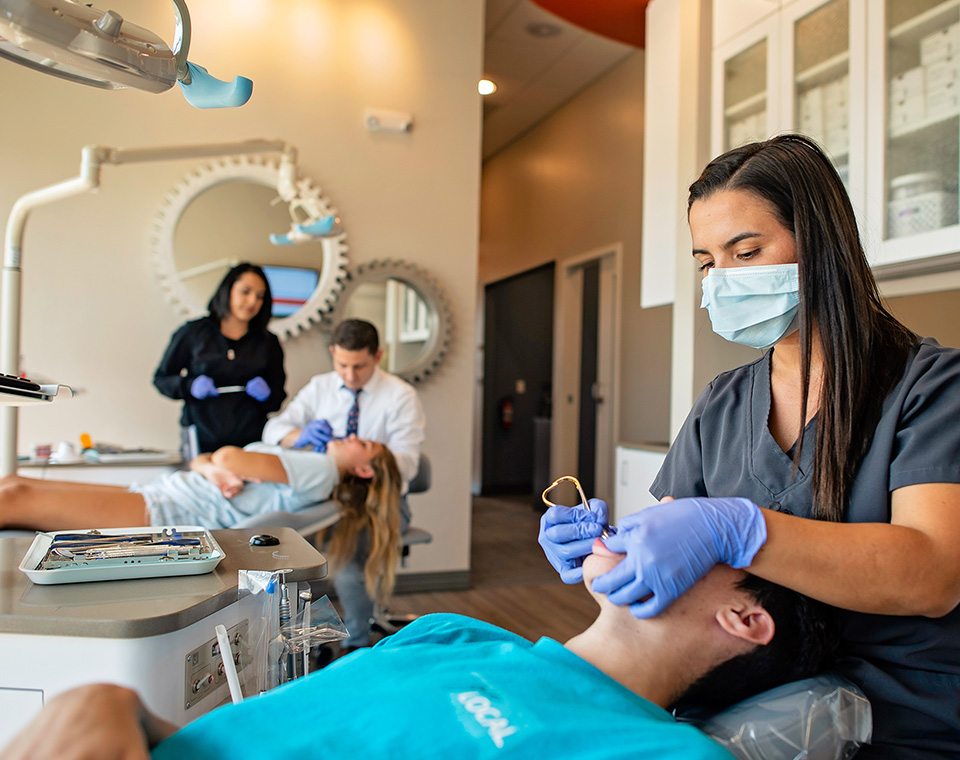What Benefits of Seeing an Orthodontist at a Young Age?

As a parent, naturally, you are protective of your child by taking precautions before making choices for them, especially when it comes to their health and care. As parents at Rose Rock Orthodontics, we understand and share the same concerns you may have about taking your child to an early orthodontic treatment specialist. Today, we want to invite you as we touch base on the importance of early prevention treatment in Enid and everything you need to know about it.
What is Interceptive Orthodontic Treatment?
Early orthodontic checkups allow an orthodontist to successfully identify your child’s possible developmental problems and address them before they begin their teenage years.
The truth is that even when it comes to your child’s interceptive orthodontic treatment, timing is crucial. Treatment that begins while some baby teeth are still present receives the name of “early” treatment and could also be called “interceptive” treatment by some specialists.
Timing is so essential that the American Association of Orthodontists (AAO) recommends that your child see an orthodontist for the first time when an orthodontic problem throws off some early warning signs, but no later than seven. What age is orthodontic treatment and what is the significance of the age of seven? By that time, your child will have enough permanent teeth for an orthodontist to assess the developing teeth and jaws, providing a plethora of information.
Let’s continue discussing early orthodontics below.
What is Two-Phase Orthodontics?
When a youngster has an orthodontic condition that doesn’t seem to be getting better, orthodontists can employ a strategy to repair it while also preventing future difficulties. This specific approach, known as developmental or two-phase orthodontic treatment, can provide your child with a healthy smile for the remainder of their life. Let’s take a deeper look at what this treatment entails.
Enid Two-phase orthodontics can help fix a variety of issues that, if left untreated, will only get worse with time. This treatment can help children who have had tooth injuries or have a restricted palate during their development. Children with a thumb-sucking habit that causes their front teeth to protrude are in the same boat.
Children with an odd bite or teeth that appear to be excessively crowded may benefit from orthodontic treatment. Finally, if your children snore or breathe through their mouths while sleeping, you should consider bringing them in, as this may necessitate treating more than just their teeth.
Phase I Orthodontics
Jaw development and permanent teeth are the focus during the initial phase of treatment. Phase I ensures the patient has enough room for permanent teeth to come in while also correcting jaw alignment. A couple of different things will happen during this phase:
Orthodontic Records
In the first phase, we will create your child’s orthodontic records. Photos and x-rays, as well as models of their teeth, will be part of these records.
Your Enid orthodontist requires every piece of this information since it’s helpful to determine whether treatment is needed. If that’s the case, the models and images will aid your orthodontist in deciding the optimum orthodontic treatment plan, including
- How many visits your child will need,
- What kinds of appliances are necessary,
- The length of time required for appliance wear.
All of the following are contingent on the quantity and nature of your child’s problems. Even if the orthodontist finds that no treatment is necessary at this time, they may recommend periodic monitoring to ensure that the jaw and teeth remain in their ideal placements.
Extraction or Appliance Wearing
One or more baby teeth may need to be extracted for permanent teeth to grow more healthily. Some children will require the use of an appliance to aid in the movement of their teeth or jawbone. Banding or bonding of teeth is one example of wearing an arch to contain any space created after tooth removal.
Waiting for Adult Teeth
There is a “resting interval” after the conclusion of phase one. This simply means that we will wait until their permanent teeth have appeared. During this time, your child will have to visit the orthodontist regularly roughly twice a year so that the orthodontist can monitor how their teeth are progressing. Their teeth would have enough room to come in and be feasible if the first step of the treatment was successful.
Phase II Orthodontics
The goal of phase II is to keep your child’s teeth healthy for the rest of their life. Phase II orthodontics entails ensuring that each tooth is aligned with adjacent teeth, tongue, cheeks, and lips.
Your Enid orthodontist will now have everything they need to compare the present position of your children’s teeth and jaws to where they were before, thanks to all of the data they made in Phase 1. The orthodontist may have to fine-tune the treatment plan at this point to account for anything that occurred between both stages.
Throughout Phase II orthodontics, you and your child can expect the following:
Installation of Braces
Beginning orthodontic braces treatment Enid on upper and lower teeth is the best strategy to achieve optimal tooth and jaw alignment. Your orthodontist will attach metal brackets to each tooth with the help of specially made-dental cement.
Between each set of brackets, a wire is inserted. This wire will be adjusted regularly to apply pressure to the teeth and help them migrate into the right place. If more effort is required to shift the jaw, rubber bands, coils, or springs may be added to early braces.
Treatment Time
Because teeth and jaws take time to shift into the proper positions, your child should anticipate wearing braces for about two years. After they’re removed, your child will need to wear a retainer for several months to keep their teeth in their new places and their jaw aligned properly.
Why Would a Child Need Orthodontics?
Being a parent is tough and requires a lot of time and dedication. That’s why we want to make things a bit easier for you so that you are able to give your child the best care possible and so that you can continue being the super parent your child deserves. Below are some specific signs that you should watch for that indicate your child could benefit from an orthodontic consultation.
- Thumb-sucking or continued use of pacifiers beyond age three or four.
- Your child breathes through their mouths more than their noses.
- Your kid snores regularly while asleep.
- Your child has a noticeable overbite or underbite where the upper and lower teeth do not come together, and the lips cannot close easily.
- There are excessive gaps between permanent teeth.
- The permanent teeth are growing crooked.
- The teeth are too close together and overlap each other (overcrowding).
- Your kid’s jawbones “pop” when they bite, chew, or talk.
- Your child has problems with biting and chewing.
- Your child bites the side of their cheeks frequently.
Available Orthodontic Treatments
Luckily, at Rose Rock Orthodontics, we love helping children achieve a perfectly straight and healthy smile and have many orthodontic treatments to help us with that important responsibility; our beautiful smiles are reached using some of the orthodontic devices below.
Traditional Metal Braces
A metal bracket is glued to the teeth in traditional braces. A tiny rubber band holds an archwire in place as it passes from molar to molar through the brackets. The period of traditional braces treatment varies depending on your child’s orthodontic problems. Treatment can last anywhere from one to three years on average.
Your child will need to see their orthodontist frequently during treatment with traditional braces.
Enid Ceramic Braces
Enid Ceramic braces are built the same as metal braces. However, ceramic braces comprise transparent materials rather than metal, making them less visible than standard braces. Ceramic braces, like regular braces, require brackets to be glued to your child’s teeth. An archwire will run through the brackets, kept in place by rubber bands.
If your child chooses ceramic braces, they will need to have them adjusted regularly by your orthodontist. The procedure is similar to that of regular braces. During your child’s monthly session, the orthodontist will tweak the wires and bands to produce more tension, causing the teeth to shift into the proper positions. The treatment time for ceramic braces is the same as traditional ones because they are so similar.
Enid Invisalign
Invisalign is a transparent, removable aligner system. The aligners are created to fit your child’s teeth and exert pressure to move and rotate the teeth gradually. Your child can remove their aligners for eating, drinking, brushing, and flossing because Invisalign is removable.
Your child’s Enid orthodontist will use a scanner to make 3D scans of your child’s teeth to fit them for Invisalign. We will create a treatment plan for your child, so you will know how long the treatment will take right away.
Enid Lingual Braces
Enid Lingual braces are a sort of braces that are inserted below the teeth and are a less well-known type of orthodontic treatment.
Dr. William will take an impression of your child’s teeth and send it to a dental laboratory to be fitted for lingual braces. In around six weeks, the lab will construct personalized brackets for your child’s teeth. Dr. Williams will then bond these brackets to the back of their teeth.
Lingual braces are available in a variety of brands. The easiest method to determine which one will best suit your child’s needs is to call and speak to a Rose Rock Orthodontics team member today.
Call Our Enid Orthodontist to Schedule Your Dental Treatment Today!
Not sure if your child needs orthodontic treatment? Don’t worry; that’s what we are here for. Call or visit our office today and schedule an appointment for your child to meet Dr. Ryan Williams.
We look forward to meeting you and your child and helping them achieve a bright and beautiful smile they can flaunt for many years to come.


